Compound Exercises
What is a Compound Exercise?
Compound exercises are a fundamental component of many strength training and fitness regimens. These exercises involve multiple joints and muscle groups, engaging various parts of the body simultaneously.
A strong foundation of strength throughout the body is beneficial for bodybuilders, athletes, and even recreational lifters. Higher muscle mass, better performance, and a higher quality of life will ultimately result from being able to lift larger weights, particularly in compound movements. Although isolation exercises are valid, they fall short of compound exercises in terms of demands on balance and coordination, weight capacity, involvement of many muscle groups, and overall “functional” training of the body.
A strength and hypertrophy workout regimen should prioritize specific exercises above others, even if there are many excellent compound lifts. These exercises are larger and include multiple joints and muscles being worked through a wide range of motion. These compound exercises are the best for increasing muscle gain and strength because they let you lift the biggest weights. Instead of prescribing to you think to be the greatest compound lifts to activate the targeted muscle groups most effectively. To develop absolute strength, you can perform the majority of these large compound exercises for 1 rep max without sacrificing any form of strength.
They differ in part from other smaller compound lifts because of this. The lesser compound exercises and accessory exercises should be used as a supplement to your training, while your primary lifts should take precedence. Lastly, you will usually just be utilizing a barbell and plates for these because they are your primary complex lifts.
Using a barbell will enable you to lift bigger objects. Except for beginners, who will assumably satisfy the most from dumbbells, and intermediate to advanced lifters who utilize machine and dumbbell compound lifts for muscle building or whatever other reason specific to their training targets, dumbbells, and machines are best for smaller compound exercises and isolation exercises.
How should compound exercises be added to your daily schedule?
Regardless of how often you train, your regimen should include compound motions. Due to their extreme adaptability, compound movements are simple to incorporate into daily routines. Nor are they always required to be loaded. Even with a bodyweight variation, the barbell back squat is a complex movement. This allows you to alter the muscle focus, load, and intensity of your complex exercises each time you work out.”Compound movements can be set up in a plethora of ways that make them extremely user-friendly.
If you do want to focus on a big compound lift, like a deadlift or squat, do it before performing any isolation training so that you are working on your most demanding exercise at the peak of your energy. Sung recommends three to five sets of five to twelve repetitions for novices, depending on the intensity of the exercise; if you’re using heavy weights, reduce the rep count.
Should an individual only do compound exercises?
A training regimen consisting solely of compound lifts is typically not the best option for individuals with well-rounded fitness goals, even if they are the most crucial and desirable for most people hypertrophy, strength, fat reduction, and endurance. Thus, there is a role for isolation exercises.
Because bigger muscle groups drive the gross movement patterning, some muscle groups may not be efficiently addressed by heavier compound motions. Compound lifts are difficult to employ to correct individual weaknesses and muscular imbalances since the stars of the show always take center stage. Your glutes will require work because you can be hamstring-dominant during deadlifts and quad-dominant during back squats.
Additionally, some muscles likely tire out during compound lifts before other muscles do. your lower back muscles might tire out before your legs do. In this scenario, you should isolate your lower back and strengthen it with hyperextensions to prevent it from wearing out before your legs and glutes. To focus on your quads, you might also need to perform more solo leg exercises like leg presses. Not to be confused with more isolated compound movements, assistance lifts are also available; however, more on this later. Additionally, you could discover that some muscles require more attention because the compound lifts aren’t pushing them to their maximum potential or their entire range of motion which is beneficial for hypertrophy
You might discover that bench press and overhead press are insufficient for your triceps and side/rear delts, or that bent-over rows are insufficient for your biceps. For both muscle growth and visual appeal, isolation exercises are necessary for these small muscle groups. Your side delts will remain underdeveloped because the overhead press primarily works your anterior deltoid and upper chest, not your broad, popping shoulders, even if you may have powerful shoulders from just performing it.
The ability to stimulate particular muscles without negatively affecting other muscles that require rest is another important benefit of isolation exercises. By doing the solo movement, you can prevent excessive use or underusing of particular muscle groups. Additionally, it will enable you to obtain the appropriate volume required for every particular muscle group. Lastly, isolation exercises are crucial for people healing from injuries. To safely assist a particular muscle or joint in regaining its strength, you can isolate it with the proper weight.
Compound exercises
Barbell back squat
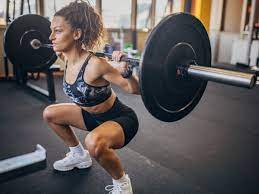
Exercises like the barbell back squat are among the best. It is regarded as the greatest compound lift for legs because it offers the most value for your money. You will gain significant strength and muscular mass in your three largest muscle groups your quads, glutes, and hamstrings by performing a barbell back squat. Through the strengthening of joints, ligaments, and tendons surrounding your knees and hips, barbell back squats also improve body awareness and coordination, lower back and core strength, and injury resilience.
Two variations exist for barbell back squats. The back squat uses high and low bars. They both have benefits and drawbacks. like the low bar Because of the increased center of gravity in the back squat, you can usually lift heavier weights, and the high bar allows you to squat deeper because it allows you to stand with your feet hip-width apart.
How to conduct: For intermediate and experienced exercisers, begin with a barbell that is either blank or burdened. Beginners should initiate with bodyweight squats and gradually increase the weight as they gain experience with the exercise.
With your hands slightly over shoulder-width apart, grasp the barbell with an overhand grip.
Place the bar on your trapezius muscles, which are the muscles nearest to the neck and upper back, as you step in front of the rack. Raise the barbell off the rack by placing your feet roughly hip-width apart. move a single step or two steps backward.
As you start to lower yourself into a squat, maintain a neutral head and spine posture by bracing the abs. Try to get your knees as nearly at 90 degrees as you can. Hold on for a moment.
Drive through your heels to get back up while maintaining your core braced. At the peak of your squat, make sure you clench your glutes. One rep is that.
Reps and sets: three eight-to-ten-rep sets
Pullover
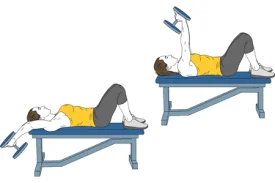
How to conduct: Lay on your side on a mat and place a dumbbell in front of you. Lay flat on your back and raise the weight to your chest using both hands. keep the space between your feet hip-width.
Grasp the ends of the dumbbell tightly in each hand.
If your dumbbell is larger, it may seem safer to hold it vertically with both hands encircling one end. As you raise it straight up above your chest, keep your arms straight.
Slowly raise the dumbbell above your head, then gently touch the ground with it.
Transfer the weight back to the starting position by using your core. Do this one rep twice a day for a total of ten reps.
The massive lattisimus dorsi muscles are specifically worked during this vertical pulling exercise. This exercise should be saved for an excellent dumbbell session because it can be difficult to recognize dumbbell vertical pulls.
Dumbbell Deadlift
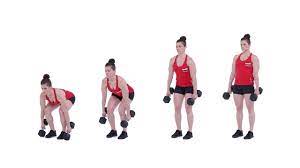
Equipment required: barbell alternative can add weights to the barbell for more effort
The forearms, lats, glutes, hamstrings, core, upper, mid, and lower back muscles are the ones being worked.
How to conduct: Toes under the bar, place feet hip-width apart, and stand with the barbell on the floor.
Push your hips back, keeping your core stretched and your spine neutral as you squat down. Your back should stay flat, not curved.
Grasp the bar with your hands. Your hands should be set on the bar lightly broader than your thighs.
Preserve your knees relaxed and drive into your heels as you start to rise.
Lift the bar so the hips and the bar grow at the same time, preserving the bar near your body as you raise it.
Complete in an elevated stance with a glute squeeze at the high point
Hang at the hips and slowly drop the bar to the floor.
In between sets, rest for at least 30 to 60 seconds and perform 10 to 12 repetitions. Do three sets of work.
Reverse lunge to balance with bicep curl
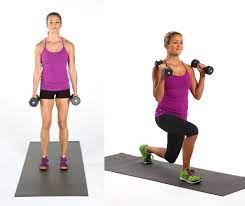
Required equipment: dumbbells
Targeted muscles include the hips, biceps, glutes, and hamstrings.
How to conduct: clasp a dumbbell in each hand while standing with the feet hip-width separated. With the palms facing the body, expand the arms downward.
With your right foot stepping back, take a deep lunge with your legs and hips.
To get back up to standing, plant your left foot firmly on the ground and step your right foot forward. Remain balanced on your left foot at the top and avoid letting your right foot come into contact with the floor.
Concurrently curl both arms into a bicep curl.
Lunge back with your right leg, lowering your arms and bringing your dumbbells perpendicular to your torso.
Before moving on to the left leg, perform 6–8 repetitions on the right leg.
After finishing the left side, take a 60–90-second break. Finish two or three sets.
Squat

Required equipment: not one
The target muscles include the calves, glutes, and quads.
How to conduct: Toes turned slightly out, start with feet slightly wider than hip-width.
As you thrust your hip back, maintain an expanded chest, contract your abdominal muscles, and return your weight to your heels.
Once your thighs are equal to the floor, or almost so, lower yourself into a squat. You should still have your knees over the second toe.
To get back to your starting posture, push via your heels with your chest out and your core tight. Tighten your glutes at the summit.
Do 10 to 15 repetitions. Do three sets of work.
Front lunge with twist
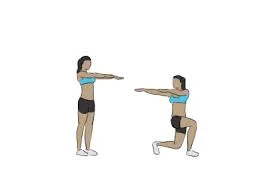
Equipment needed: none
target muscles: hips, hamstrings, glutes, and abs
How to conduct: With your feet shoulder-width apart and your arms out in front of you, take a high stance.
With your arms extended, take a lunge by stepping your right foot forward. Your knee shouldn’t go past your toes, and your front leg should make a 90-degree angle. Additionally, your back leg will be in a 90-degree angle.
Rotate your upper body to the right while in the lunge posture, then back to the center.
Lunge forward and act with the left leg after bringing the right leg back to the starting position.
Lunge 8–10 times on each leg. Do three sets of work.
Dumbbell shoulder press on an exercise ball
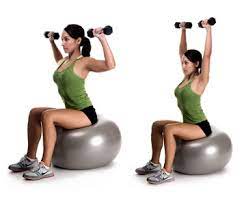
Exercise balls, abs, and dumbbells are required pieces of equipment.
Targeted muscles include the deltoids, pectoralis major, triceps brachii, and abdomen.
How to conduct: Start with your abdominal muscles engaged while sitting on an exercise ball. With each hand, hold a single dumbbell.
Dumbbells should be started on your thighs, and you should use your thighs to help you raise the weights to shoulder height while maintaining a 90-degree angle and facing forward with the dumbbells.
Raise the dumbbells until your arms are straight above your head.
Come back your arms to a 90-degree angle gradually while maintaining your elbow at shoulder height. Avoid lowering yourself below this point as it may cause strain on your shoulder joint.
Do 12 to 15 repetitions. Do three sets of work.
Rotating high plank T-spine
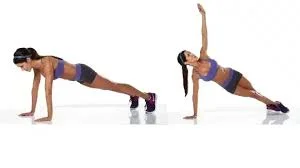
Required equipment: not one
muscle worked: shoulders and abs
How to conduct: begin with your arms beneath your shoulders and your core tight. For this exercise, your legs should be around hip-width apart.
Squeeze your glutes and thighs while firmly planting your right hand on the ground.
Raise your left arm and drive your hips and shoulders up toward the ceiling while twisting them in a leftward direction.
Lower your left arm to the floor and plant your left hand firmly on the ground.
To raise the right arm in the air, alternate and twist.
Do 8–10 repetitions on each side. Do three sets of work.
Dumbbell press squat
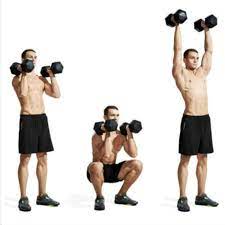
How to conduct: Carrying weights by your ears, elevate your arms to shoulder height with the elbows bent, and stand with your legs a bit farther than hip distance apart.
Maintaining the weight on your heels, bend your knees like sitting in a chair.
To go back up to standing, straighten the knees and push the dumbbells overhead.
Stepping Lunge
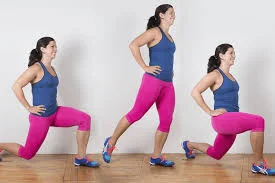
How to conduct: Keeping your feet together and erect, hold ten-pound dumbbells by your sides. Walking lunges can be performed by beginners using only their body weight.
Bend both knees to a 90-degree angle and take a purposeful stride forward with your left leg, lowering your hips toward the floor. Your front knee should be squarely above your ankle, and your back knee should point toward the ground without touching it. Step with power into a lunge on the opposite side by pressing your left heel into the ground and pushing off with your right foot to bring your right leg forward. One rep is that.
lateral lunge With Bicep Curl
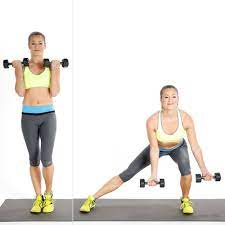
How to conduct: Place both of your feet together, grip a dumbbell in front of your shoulders with the palms facing in, and begin standing.
With the heel of your left foot, take a large step out to the side while keeping your toes pointed forward. Reach dumbbells toward the ground on either side of the left knee as you lower yourself into a lateral lunge by sitting your hips back and bending at the knee. Maintain your back flat and your abdominal muscles active.
As you curl the dumbbells up to your shoulders, push off your left foot to stand again and step your left foot next to your right. One rep is that.
Barbell deadlift
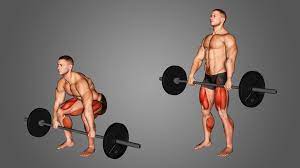
The deadlift is the most powerful compound activity available to you since it can lift the largest weight. Without a doubt, that ought to be your strongest lift.
One of our favorite barbell workouts is the deadlift, which will significantly increase your upper and lower body strength and muscular mass. Although your quadriceps, glutes, hamstrings, and back are the primary targets, it’s a full-body posterior chain workout. Naturally, because you have to hold onto the barbell, it also strengthens your bones and develops strong forearms and grip.
Deadlifts will also enhance anabolic hormones most, just like squats do. Additionally, deadlifts develop neurological strength adaptations that transfer to complex movements of the upper and lower bodies, such as squats and barbell bench presses. All of your lifts will get stronger the more powerful your deadlift is. It is the most effective power enhancer.
There are deadlift substitutes to take into consideration if you are unable to perform deadlifts for any reason (lower back pain when deadlifting is common; this is a high-risk, high-reward type of workout).
Steps to Take: Step under the bar with your feet shoulder-width apart to begin. Your shins ought to be in contact with the bar, if not touching it.
To reach the bar on either side of your legs, push your buttocks back and flex at the waist.
Take hold of it with an overhand grasp with both hands.
preserve in mind that your shoulders and hips are in line. To straighten your spine and remove the slack from the bar, squeeze your shoulder blades together.
Maintain a close grip on the bar as you raise the weight. Until your shoulders, hips, and knees are all piled on top of one another, tighten your glutes.
repetitions and sets: to begin, perform 3–4 sets of 6–8 repetitions.
Barbell benchpress
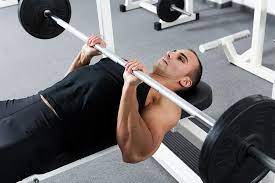
Squats are to your lower body what the barbell bench press is to your upper body.
This will be the best compound lift for your chest and the strongest workout for your upper body.
You will increase your chest’s muscle and strength by performing the barbell bench press, an activity that involves pushing horizontally. This is undoubtedly the best lift for your money because your chest is one of the largest muscle groups in your body.
As you force your arms straight and then drop them back down, it will allow you to move your chest through a wide range of motion. This will help you grow muscle by strengthening and stretching your chest, as well as by enhancing posture and back strength
The bench press engages several muscles in addition to its main muscle group. It will strengthen your lats as well as your triceps and anterior deltoids. It builds up your core as well. Moreover, different bench press grips will change the stimulus applied to your muscles. Overall, the bench press is among the best workouts for the upper body that you may perform.
How to do bench press: Place your feet flat on the ground and lie down on the bench. Squeeze your belly button back towards your spine to tighten your core and keep your glutes engaging.
Dumbbells or a barbell should be placed precisely over your shoulders to begin. As you descend, inhale and consider bending at a 45-degree flex in the armpits
preserve the forearms equal to the ground
Push up and release the breath.
Sets & reps: begin with three sets of eight to twelve reps.
Dumbbell bench press

How to conduct: Seated on the floor or a flat exercise bench, grab a set of dumbbells.
Reposition yourself back on the bench with one dumbbell in each hand resting on your thighs.
With the dumbbells shoulder-width apart, hold them over your chest so that your upper arm and forearm are at a 90-degree angle. The palms ought to be pointing forward.
Breathe out as you raise the dumbbells to your full arm length. Hold on for a moment.
Taking a breath, carefully lower the dumbbells to your sides. One rep is that. execute 10 reps, twice a day
Dumbbell military press
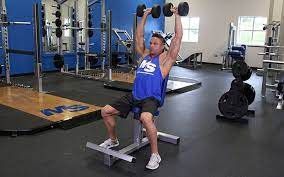
The primary form of the overhead shoulder press is the military press, often known as the rigorous press. It is the final exercise of the Big Four that strength and powerlifters compound movements. This is an additional workout where you can perform 1 rep max lifts with high weight.
A vertical pressing exercise that develops shoulders like boulders is the military press. It’s the best compound raise for arms and one of the hardest exercises you will perform.
It improves your upper chest and triceps as well as your biceps and lats to some extent, in addition to adding significant mass and strength to the shoulders. Additionally, it works wonders for strengthening the glutes and abdomen. as these muscles should work very tough to hold stability when thrusting heavy pressure beyond the head from a standing position
The military press should also executed in a sitting manner
For athletes, this is a crucial workout because it develops a tremendous amount of initial strength and power. You’ll be able to exert force without gaining momentum before the movement. The military press can be compared to a reverse deadlift. It is a whole-body workout. Additionally, the military press targets every muscle that the deadlift fails to reach. In terms of developing total strength and muscular hypertrophy, the military press is an extremely challenging exercise that is on par with the barbell squat, deadlift, and bench press. You have the entire strength training package with all four. Although powerlifters can get by with the aforementioned four exercises, there are additional compound workouts that are essential for those people who desire to do a more well-circled hypertrophy and strength workout strategy
How to conduct: Seated on an inclined bench, pick up a pair of dumbbells. Verify that the bench’s back is positioned at a 90-degree angle.
After taking a seat, place a dumbbell on each thigh. Place your lower back solidly against the bench’s back when you sit. Maintain as much straight back and shoulders as you can.
Elevate the dumbbells so they are shoulder height by raising them off your thighs. Raise each of your thighs separately to assist in lifting big weights. An injury could result from raising a heavy dumbbell with just your arm. As you hold the dumbbells at shoulder height, turn your palms to face front. You can also perform a dumbbell press with your hands facing your body if that’s how you choose. Verify that your forearms are equal to the ground
Press the dumbbells above your head until your arms reach their maximum length. After a brief period spent holding the weight above your head, return the dumbbells to shoulder height.
Perform the necessary number of repetitions. For beginners, begin with one set of eight to ten repetitions.
Pull-up
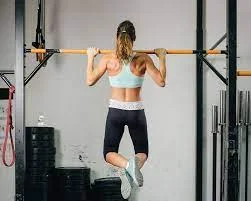
Whether you are a mom working a full-time job or a bodybuilder, powerlifter, weightlifter, cross-fitter, or something else entirely, pull-ups are a must. Pull-ups are essentially a crucial component of the puzzle that is often overlooked by powerlifters because they don’t directly correspond to total strength. Relative strength, or the capacity to lift your body weight, is what pull-ups are all about if you can’t do pull-ups, start our pull-up progression program
Pull-ups are essential because they focus mostly on the lats and biceps, two muscle groups that have not previously been the main focus of exercise. Not only do pull-ups target them, but they also work best when performed in certain forms, such as chin-ups and neutral-grip pull-ups. Furthermore, pull-ups engage more than just two muscular groups, much like all of our other key complex workouts. Pull-ups will also work your core, traps, deltoids, and rhomboids. Thus, the next time you train again,
Ensure that you arrive at the pull-up bar. You’re using your entire body weight to raise the weights, so your biceps have access to more weights than you should be lifting with a barbell. Make sure you’re keeping the attention on your biceps by contracting your core muscles and pulling your shoulder blades downward.
How to achieve: Hang from a bar with your hands shoulder-width apart or slightly wider, with your palms facing you.
Press your shoulder blades together while hanging down.
Keep your body from folding on itself as you elevate the body until you reach above the bar.
Coach’s Suggestion: Imagine slightly tucking your elbows into your back pockets.
Reps & Sets: Perform three or five times
Barbell bent over row
As the bench press is to your front upper body, the bent-over barbell row is to the posterior upper body. Rowing, or pulling, is a basic action, much like pressing, and the best dragging compound lift is the barbell bent over the row.
Your traps, lats, rhomboids the muscles between the shoulder blades, teres major, teres minor, rear delt, and infraspinatus will all gain mass and strength from a bent-over barbell row. It also targets your abs, glutes, and spinal erectors in an isometric manner. In addition, since it’s a pulling motion, your forearms are required for grip strength, and your biceps will be used to power the exercise. The bench press and a bent-over barbell row are directed reverse to each other together, they provide the equilibrium required for both strength and proper posture. Not to mention attractive design.
You may be asking yourself why one of the most potent compound lifts in powerlifting isn’t included. Despite being one of the best compound lifts for the back muscles, powerlifting regimens don’t always include the bent-over row because of process breakdown.
Reaching a real 1 rep max in rowing without lying or sacrificing form is incredibly difficult. The bending over the row would be useless if you reduced the range of motion, stood up with the bar while you pulled, or simply used momentum and abrupt movements.
It is either you receive the lift-up from the beginning posture or it is not. Furthermore, there’s virtually no way to cheat, even though there may still be some minor form problems. All in all, powerlifting’s primary objective is pure strength, and maintaining precise form while training for it can be challenging. Consequently, rows are merely seen as assistance exercises used to enhance deadlifts, which constitute the true back movement in a powerlifting regimen.
The bent-over row should be your primary exercise if, like the great majority of gym-goers, your goals are hypertrophy and strength since it targets the mid-upper back more precisely and with a greater range of motion than a deadlift from an aesthetic perspective, it’s a highly significant lift for the development of the muscles in your back, and there are various versions of bent over rows that can be beneficial as well.
Why it rocks: Unlike other upper-body dumbbell workouts, you can lift more weight with this one because your back is so strong.
How to conduct: With your feet hip-width separated, stand with your hands on a dumbbell in each hand and your arms at your sides.
Sustaining core stability, lean forward at the hips while forcing your gluteal area backward. shouldn’t flex the legs and twist the shoulders. How well your hips move and how flexible your hamstrings are will determine how far you should bend over.
To keep your neck in the proper position, have a look at the ground a few inches in front of the feet
During a row, raise the weights to your chest. At the peak of the exercise, squeeze your shoulder blades while keeping the elbows close to your body. Your elbows should be past your back as you draw the weight in toward your chest.
As you progressively lower the weights, extend your arms in the direction of the floor. This is one rep. Do ten repetitions twice a day.
This traditional dumbbell back workout works the stabilizing muscles in your core as well as your lats, rhomboids, and biceps. It’s a great exercise to include in a push-pull routine or any other back and chest exercise.
Reps and sets: three sets of eight to ten reps
Lowercase row
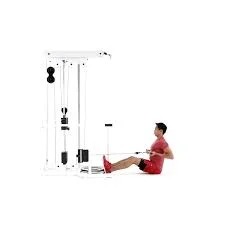
How to conduct: place a dumbbell in each hand, palms facing up, and hold them at your sides while keeping your feet hip-width separated.
To maintain core stability, lean forward at the hips while thrusting your buttocks back. avoid flexing your legs while rotating your shoulders. The ease of movement of your hips and the flexibility of your hamstrings will determine how far the bend goes.
Aim to keep your neck in a comfortable position by looking a few inches in front of your feet.
When performing a row, lift the weights to your chest. Keeping your elbows close to your body, tighten your shoulder blades at the peak of the exercise. Verify that your elbows are extending past your back as you bring out the weight toward the chest
Reaching toward the floor with your arms, gradually reduce the weights. It is one rep. Do ten repetitions twice a day.
This rowing variation works your biceps and lattisimus dorsi more than the standard row does.
Alternate bent-over row
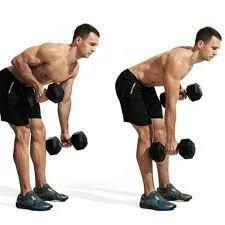
Why it rocks: Unlike other upper-body dumbbell workouts, you can lift heavier weights with this one because it takes advantage of your body’s strong back.
What it does: This exercise targets your mid-to-lower traps, rear deltoids, and lats.
How to conduct: Take a standing position with a dumbbell in each hand and your palms facing inward.
Bend forward with your knees slightly bent, keeping your torso almost equal to the floor or slightly above it. The muscles of the abdomen would initiate to work as you thrust the gluteal region back and lower the chest
Take a breath out, then begin the exercise by squeezing your elbows behind your body and pulling your shoulder blades back. Your thumb should be pointing toward your ribs.
Draw the dumbbells in the direction of your body until the elbows are at the midline.
Breathe in as you progressively lower the weights back to the starting position. Do 10 to 15 repetitions for one rep, or twice a day.
Barbell hip thrusts
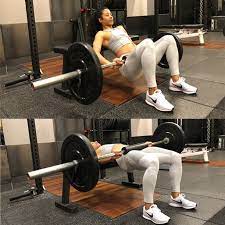
the barbell hip thrust to this as one of the finest exercises for growing glute bulk, especially for people who feel that their glutes aren’t receiving sufficient attention with squats and deadlifts and for those who simply want good and powerful booty
Another key benefit is that it enhances rather than duplicates deadlifts and squats. While deadlifts and squats require a vertical hip hinge, this exercise involves a horizontal hip hinge. A targeted exercise is crucial for overall hypertrophy because your gluteus maximus is the largest muscle in your body and your gluteal muscles constitute one of the largest muscle groups. Because it’s a hip-hinging movement, the main muscles used are your gluteal and hamstring muscles. You’ll also be training your quads and core to some extent.
The barbell hip thrust offers the highest level of contraction tension, which is why it’s so beneficial for your glutes. There isn’t a comparable exercise. The barbell hip thrust has the drawback of having very little stretching stress. Therefore, although it is superior to the squat for contraction tension, the squat is superior to it for stretching tension. As a result, both exercises are equally important and beneficial for the glutes, which serves as a reminder to dig deep during back squats to maximize glute activation.
Try these barbell hip thrust substitutes if you’re unable to perform barbell hip thrusts or simply do not wish to.
How to conduct: Place your legs outstretched and lean your back against a sturdy bench while seated on the floor.
For comfort, place a towel or shoulder cushion on the bar (optional). rolls the barbell across your thighs, till the bar should instantly beyond the hip joints. Become core-braced. Squeeze your glutes to raise your hips to full extension, or until your knees and hips are parallel to each other, as you plant your heels firmly into the ground.
Return to the floor by lowering yourself with control. One rep is that.
Plank

For everyone, the plank is a need. Your core is the structural glue that ties your upper and lower bodies together, therefore this is the finest workout you can perform to strengthen it. It needs to be a part of powerlifting’s primary lift. A “jack-of-all-trades” type of exercise is what planks should like. It transfers to all of your major lifts, which you may perform whenever and anywhere you choose. Furthermore, they benefit more than just your abs! Planks exercise your entire core, including Your trunk’s deep muscles, glutes, spinal erectors, obliques, and abs. They also strengthen your chest, triceps, shoulders, and quadriceps! Naturally, this is all accomplished through isometric contraction, or contraction without causing muscles to extend or shorten.
Planks are therefore essential for any regular strength training and bodybuilding program. They will increase your strength for other lifts, stability, resistance to injury, and help you maintain proper posture. choose a posture that allows you to fully extend your torso. You can have adequate cushioning to feel comfortable on all fours if you use an exercise mat. As seen in the video, you have the option to execute a plank on your forearms or palms. There is a selection of wrist wraps available to give joint support
How to conduct: initiate in the plank position, with your forearms and toes on the ground and your face down. the forearms are pointing forward, and the elbows are exactly beneath the shoulders. You should be staring at the floor, yet your head is relaxed.
Pull your belly button toward your spine by using your abdominal muscles. Maintain a firm and upright torso, and maintain a straight body from your ears to your toes, without bending or sagging. The neutral spine posture is this. Ascertain that your shoulders are down and not tucked up toward your ears. The balls of your feet should be beneath your heels.
For ten seconds, maintain this posture. Let go to the ground.
Work up to thirty, forty, or sixty seconds over time.
Most common mistakes
To get the most out of this workout and to prevent strain or injury, steer clear of these mistakes.
Arching your back: When you arch your back, you transfer more of the weight to your arms and fail to fully engage your abdominals. Make sure you maintain wide and downcast shoulders.
Sagging hips: When your abs are as tired as they can get, your hips will begin to sink. That’s a clue that your plan needs to be terminated. Try spreading your feet a little wider and concentrate on using your abs if it feels like your hips are drooping from the start.
Head tilting: Your neck should be parallel to your body rather than angled upward, as this could put a strain on the neck. Preserve the gaze down at the floor
Push-ups

why: A common bodyweight exercise that targets far more than just the chest is the pushup. Sung claims that because the workout is so adaptable, anyone can incorporate it into their routine. There are also lots of options for various focal points.
Steps to Take: With the palms of your hands on the floor, wrists folded beneath the shoulders, and your spine in straight alignment, begin in the high plank position.
Consider driving your hands into the earth. Just below you, maintain a neutral neck position.
With your elbows positioned roughly 45 degrees apart from your body, lower your chest to the floor.
Push upward all the way.
Reps and sets: 12–15 reps in three to four sets.
AB wheel
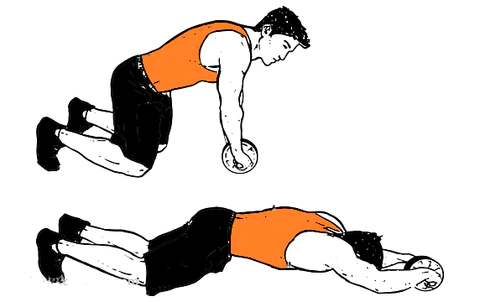
why: This little device has a lot of power. Don’t be scared to use an ab wheel if you have one available to you. Almost all of the muscles in your abdomen, shoulders, glutes, and lower back are worked during this exercise.
Steps to Take: With the palms of your hands on the roller, begin on the knees.
As if you were performing a plank, carefully move your body as far away as you can while keeping your spine neutral. You’ve gone too far if your hips begin to rise or overextend.
Make sure to move slowly and precisely.
3 to 5 sets of 5 repetitions for reps
Kettlebell overhead press reverse lunge
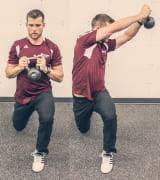
How to conduct: Using your left hand, grasp a dumbbell or kettlebell weighing five to twenty pounds at shoulder height.
After stepping your left leg behind you to perform a reverse lunge, stand back up.
After you’re standing, raise the kettlebell above your head while keeping your elbow slightly bent. Keep your arm close to your head rather than letting it swing wide.
come back the left arm to its initiate position by lowering it. One rep is that. execute 10 reps, twice a day
Knee Drive Deadlift
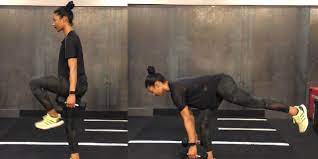
You can perform this workout without any weight if you’re a beginner. Take out a set of dumbbells for higher difficulty levels.
How to conduct: Grasp a dumbbell in each hand, and stand tall.
Hinge at the hips and drive your hips backward while maintaining your spine in neutral and using your core. Raise your left leg off the ground at the same moment. Make sure your left foot is flexed and your left knee pointed downward don’t point your toes. The bottom of your leg should be in line with the back as you keep doing the hinge at the hips till your back is perpendicular to the ground. The top of your head and neck should be in a neutral position, and the back should be flat.
Without putting your left foot down on the ground, stand back up. After you’re standing up straight, raise your left knee such that the angle at the knee joint is 90 degrees. Dorsiflexing your left foot should still be the norm. Throughout the entire exercise, make sure to maintain your posture and your core active. One rep is that.
Hex Bar deadlift
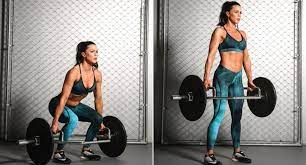
Choose the weight you want to put on the hex bar. If you’ve never done this exercise before, begin by simply using the bar by itself without adding any weight.
How to conduct: Place yourself in the middle of the hex bar, hip-width apart from each other.
Grip the hex bar handles while bending at the hips and knees. To tighten your back, lift your hips a little while maintaining a flat back of the legs, the hamstrings will feel contracted
Stand straight up by driving your heels through the ground while maintaining a flat back and relaxed shoulders.
To guarantee that you get a complete hip extension, contract your glutes at the peak of the movement.
As you steadily reduce the weight to the floor, hold onto the handles. Make sure your back is flat and your chest is open. This is considered a single attempt. Execute 8 to 10 attempts, twice a day
Bulgarian Split Squat
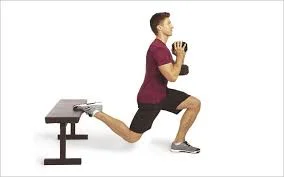
Try this maneuver with just your body weight if you’re a beginner. For those with more experience, pick yourself a set of 10-pound dumbbells. Starting with your right leg straight, place the toes of your left foot on a chair, bench, box, or stair.
Make sure your right foot is sufficiently out of the way so that when you lower your hips. the knee remains directly beyond the ankle. As low as you can, or till the front of your thigh is equal to the floor, bend your right knee, contract your left glute, and drop the pelvis toward the floor.
To straighten the knee on the right, firmly plant your right heel on the ground. One rep is that.
Slider knee tuck with Push-Up
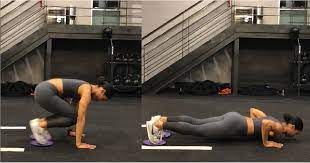
How to conduct: posture a slider beneath each foot and begin in the plank posture. You can execute this workout on a hard surface with a towel if you don’t have sliders.
Obtain both knees in toward your elbows while activating your core. Return to the beginning location under control.
Next, perform a push-up. During every motion, the back of your body should remain neutral and the abdominal muscles should be active.
One rep is that. carry out eight to ten tries twice a day.
Burpee squats press

How to conduct: With a 10 kg dumbbell on either side of your body, start off standing. Use lesser weights if you find that your form is off and this is too heavy.
Grasping the dumbbells, descend and execute a burpee. You can place the dumbbells down in front of you for this exercise if you feel that it would put too much strain on your hands or wrists. A simplified burpee can be performed by a beginner.
Thrust your body off the ground while concurrently picking up the dumbbells with control. When you force yourself off the ground, be sure your spine is neutral and your core is working.
Bend your arms, grasp the dumbbells on or just above your shoulders, and lower yourself into a squat while maintaining a tall stance and an involved abdomen. Thrust both dumbbells overhead as you stand up. One rep is that. carry out eight to ten tries twice a day.
Arnold Press
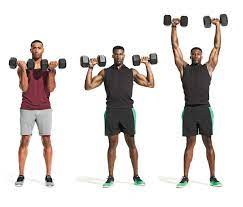
How to conduct: Begin by putting dumbbells right in front of your face and bending your arms to a 90-degree angle.
Stretch your arms out to the sides while keeping your elbows bent.
Lift weights straight up until your arms are fully extended.
Reverse the entire movement to get back to the beginning. One rep is that. carry out eight to ten tries twice a day.
Upright Row and deadlift
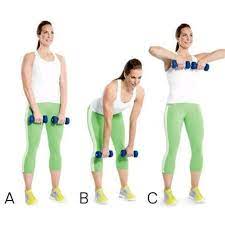
How to conduct: Preserve a slight bend in your knees and stand hip-width separated.
Keeping a neutral spine, hinge forward at the hips, contract your core, and move the weights along your shins.
Come to standing carefully. After reaching the summit, maintain your elbows out to the side and raise your arms to your chest. One rep is that. execute 10 reps, twice a day
Squat, curl, and press
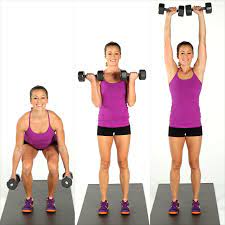
How to conduct: Grasp a dumbbell in each hand and place your feet squarely beneath your hips as you stand. Return to your squat by sitting back and lowering yourself till your thighs are equal to the floor, but do not allow your knees to cross your toes.
After raising the weights to your shoulders and pushing via your heels to stand again, execute a bicep curl.
Goblet Squat
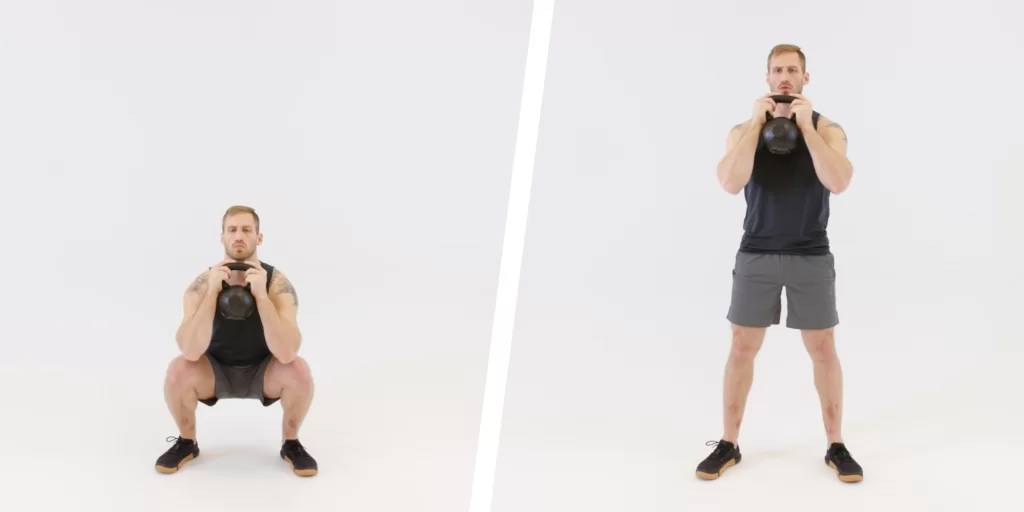
How to conduct: Place your feet wider than shoulder-width separated and tip the toes slightly outward while standing. Using both hands, grasp a dumbbell or kettlebell at chest height.
Press your hips back, bend the knees, and lower your entire body till your thighs are perpendicular to the floor while maintaining an engaged core.
Bring yourself up to the beginning posture by keeping your weight concentrated on your heels. One rep is this, execute 10 reps, twice a day
the relevant muscle is that: Vastus lateralis, vastus medialis, vastus intermedialis, gluteus medius, gluteus minimus, gluteus maximus, and rectus femoris
Reverse lunge with one leg raise
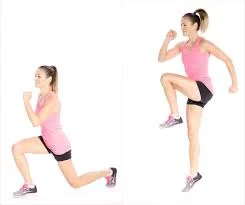
How to conduct: Standing with your feet shoulder-width separated, tighten your core. This is where it all starts.
Step backward with the right foot, keeping the right heel off the ground and landing on the right foot’s sole.
Bend both knees to a 90-degree angle as the person lowers themselves into a lunge. Bend your elbows and raise your right arm forward while extending your left arm slightly back. Retain your hips curled inward; do not attempt to elongate your buttocks with your associated abdominal muscles.
Hop as high as possible while using your left foot to press your right knee toward your chest.
Gently land on your left foot in a standard position, then shift so that you can make another lunge. Ten reps are executed in one rep.
Finish all of the repetitions on one side. Next, switches sides and performs the reverse lunge to single-leg hop again.
The targeted muscles are the hamstring, gluteus, and quadriceps femoris.
Benefits of compound exercises
While some beginner fitness enthusiasts might believe that isolated exercises are sufficient as long as every muscle group is used, this is not a wise strategy for developing strength and muscle. Compound exercises are the foundation of any efficient fitness program, while isolation exercises are the complement to those exercises. This holds for everyone, from newbies to the best weightlifters and athletes.
Compound lifting should be prioritized more by healthy newbies even though isolation exercises are simpler and less demanding. Compound lifts remain the gold standard, but isolation workouts become very beneficial if a trainee has a strong base of bulk and strength.
Train many muscle groups simultaneously: Compound exercises, or complex lifts, increase training effectiveness, but that’s not the main idea. You can increase your overall strength and muscle mass by lifting greater weights by training many muscle groups at once. With most compound movements, gaining muscular mass and strength is much simpler. Functional fitness is best defined by compound lifting.
Greater Ease in Gradual Overload: You can strengthen your muscles more quickly as a novice or even advanced lifter since you can boost the weight of compound strength exercises far more quickly than you can with isolation exercises! For compound lifts, the ceiling is significantly greater.
Boost Growth Hormone and Testosterone: Compared to isolated exercises, compound lifts result in significantly greater increases in these two anabolic hormones. That is an additional factor that makes them better at gaining muscle.
Stronger, Denser Bones: Lifting more weights will strengthen your bones in addition to your muscles. Compound lifts will help your bones get stronger and denser as your muscle mass and strength grow. You develop actual entire body strength in this manner.
Enhances Intermuscular Coordination: By using more intricate lifting techniques in compound workouts, you can train your muscles and joints to work together as a single unit rather than as a robot. Together, they generate and manage force. You will experience significant gains in your balance, coordination, and efficiency of movement as a result.
This is particularly helpful if you wish to improve your athletic ability. Compound exercises, however, are functional movements, which means they prepare you for the real world, which is something we all engage in, even if you don’t care about athleticism.
Increase Calorie Burn: Compound workouts burn more calories than isolation exercises because they need a larger movement pattern and a higher net energy expenditure. If you value losing weight, then complex exercises are the best option. Furthermore, you will burn more calories when at rest if you have greater muscle mass. That is a fat-burning double punch.
Enhances Flexibility and Mobility: Many individuals are unaware that performing compound lifts is essentially a type of dynamic stretching. Stretching and contracting your muscles with each repetition during compound lifts that take you through a wide range of motion enhances flexibility and maximizes joint mobility check your mobility.
Boost Your Muscle and Strength: You can load complex motions with greater weight than you would when you isolate a single muscle because multiple muscle groups work together to perform the exercise. Using the progressive overload principle, which challenges your muscles to adapt and expand in response to greater stress, is a dependable method of building strength. You will be capable of challenging the muscles more with big motions
Effectiveness: Compared to a plan consisting solely of isolation exercises, compound exercises target many muscle groups simultaneously, allowing you to train your entire body with fewer exercises. Although a deadlift is primarily a lower body exercise since it uses the hamstrings and glutes to drive hip extension, your back muscles are also essential for maintaining load stability as you draw from the floor. Your pectoral muscles and triceps cooperate to push the weight above your head during the bench press exercise. Your pecs adduct while your triceps extend your elbows. You will also burn more calories when all of these muscle groups are working simultaneously. These exercises will, all things considered, provide you with better value for your money.
Solidity: Compound movements need you to use numerous joints at once, therefore stability is essential for success. While our larger muscles provide the force for the movement, our smaller stabilizing muscles will contract to maintain the motion through our joints. Compound workouts nearly always involve a high degree of stability and increased neuromuscular coordination.
Energy: Don’t mistake the need to catch your breath for being out of shape if you’ve ever felt exhausted after performing a set of front squats. When performing a set of compound exercises as opposed to isolated exercises, you will expend a lot more energy. Their cardiovascular component is stronger.
When you’re doing an exercise like a squat, a lunge, or a deadlift, it’s extremely taxing to the nervous system. In compound exercises, the central nervous system will also be heavily involved. You’ll feel this kind of exhaustion as you execute these huge changes, so it’s critical to approach them with a new perspective.
Maximal Hypertrophy: Large muscular groups are worked during compound lifts, which enhance general strength and muscle growth.
Saving Time: When compared to isolating individual muscles, complex lifts can save time in your workout regimen. They work on several muscle groups at once, so you can accomplish more.
The common mistakes occur during compound exercises
Exercises for Compounds Are Not One Size Fits All
Not everyone is suited for every complex workout. Even though the barbell back squat is one of the most often used lifts in programming, your physique and skill level may not be a good fit for it. Common exercises may not be effective for you if you have mobility limits, an anatomy that isn’t optimal for certain movements, or prior difficulties from accidents. The good news is that there are other approaches to getting your compound lifts in, such as rearranging the equipment or weight placement.
Don’t Go Overboard
It might take the person some time to recognize a baseline for how an activity should feel if he/she is new to strength training, inexperienced lifters cannot have the muscular endurance or stabilization, to be capable of preserving a good position, all over a lift.
Regarding how fit you are, be truthful with yourself. Adjust the weight, sets, and reps appropriately. Although many fitness gurus and athletes don’t need to be performing maximal barbell squats and deadlifts, you may be accustomed to seeing them do so.
Many people eventually fail miserably at first. Furthermore, they lack the patience and awareness of how exhausting failure can be. it is okay at the starting point to cut yourself a brief rep so you should maximize each rep and create that foundation beyond time
Don’t Underperform
However, a common mistake made by many is not pushing themselves on more difficult compound exercises, which goes beyond simply not lifting high weights. Compound movements can be made more difficult without piling on the plates, in several methods, for as by slowing down the eccentric phase of an exercise or adding pause reps. By breaking you from doing the same sets and repetitions of the same weight, these exercises will help you gain strength and muscle.
Safety
Consult a physiotherapist or other fitness specialist at your gym if you have any questions about how to do a compound exercise correctly. They can demonstrate the proper method for preventing injuries. Consult the physician before initiating a new fitness regimen. They can suggest a secure exercise regimen for the fitness regimen. Compound workouts, like deadlifts, call for a particular form to keep you safe and prevent harm.
When doing these exercises, especially if you’ve never done the move before, work with a trainer or fitness expert. They can watch you to ensure you’re using the correct approach. You could eventually be able to do the motions safely by yourself. Nevertheless, it’s a good idea to work out with a partner who can see you.
Speak with a trainer or other fitness expert at your gym if you’re a newbie. They can assist you in determining the appropriate starting weights. Starting with a lightweight that you can easily perform 10 to 15 repetitions within a set is a decent general rule of thumb.
For the second and third sets, up the weight if it seems stable and comfortable for you. During the final few repetitions, you should experience the burn, but you should never feel unsteady. If you feel dizzy, drained, or sick, pause the workout and drink some water in between sets.
Conclusion
Making the most of your gym time can be achieved with compound workouts. Every few weeks, try to switch up your regimen and incorporate some new compound exercises.
You’ll be able to work more muscle groups, and avoid frustration, and plateauing thanks to the variety. Ask a trainer or other fitness expert at your gym if you have any questions about how to execute a compound exercise correctly. They can demonstrate the proper method for preventing injuries.
Before beginning a new workout routine, watch the doctor they should suggest a safe program schedule for the fitness level
the basis of your program is comprised of compound lift movements. Your main muscle groups will be properly trained and overexerted by these exercises. They are the source of your general strength and size gain. The purpose of the more solitary workouts is to assist you in developing particular muscles or muscle areas that require greater focus. They are there to assist you with weak muscles, uneven strength, and general appearance.
FAQs
Why utilize compound Exercises?
An exercise routine consisting mostly of compound movements can provide you with the necessary results if you’re hoping to increase your general strength as well as get in an effective and useful workout. Separation is frequently more appropriate if your criteria or goals are more precise. Combining compound movements as the base of the training with isolation exercises as the top layer to target different muscle groups might result in a very efficient approach.
What is a compound workout?
In a compound exercise, many muscle groups work together to complete a movement, such as Exercise ball dumbbell shoulder press: This exercise works the abs, deltoids, pectoralis major, and triceps brachii in unison. workouts that are compounded are not isolation workouts. These target just one muscle group at once.
Which five compound workouts are the golden ones?
The Big 5 of strength training are the five exercises: bench press, deadlift, squat, shoulder press, and pull-up.
Can we perform complex workouts every day?
Compound workouts should be safe for you to do two or three days a week if you’re a healthy adult Each day, concentrate on different muscle groups. Between strength training sessions, give your muscles at least 48 hours of rest.
Should Someone perform every compound workout?
It is best to focus your training mostly on compound exercises if you want a thorough, effective, and functional workout. However, there are instances in which it is required and advised to isolate a particular muscle, muscle group, or joint.
Does one lift per day be sufficient?
because of the insufficient variety and variety in the exercises, this program can be extremely dull at times, but it does a great job of building muscle. Powerlifters can also benefit from one lift every day since their primary objective is to be the strongest in the big three lifts: the squat, bench, and deadlift.
should compound workouts increase size?
Increasing your muscle mass and burning more calories in less time can be achieved with compound exercises. Exercises that work several muscle groups simultaneously improve your coordination and general strength.
Can abs be built with compound exercises?
If crunches and planks haven’t been able to give you the abs you want, complex activities may hold the secret to realizing your six-pack potential.
Do push-ups qualify as a compound exercise?
Push-ups are a type of compound exercise that works the chest, anterior deltoids, triceps, glutes, core, and lower back muscles, among other muscles in the body.
should compound workouts promote fat burning?
Yes, complex exercises are effective in burning fat not just from the belly but from every part of the body. When you first start your fat reduction journey, maintain a firm starting position with your back straight, and chest out, and perform the exercises that are most appropriate for your physique. Make sure to monitor your caloric expenditure.
Do compound workouts help develop large arms?
You only need to perform complex exercises to increase the size of your triceps and biceps. As you get more experience lifting weights, you’ll probably need higher volume to maintain your hypertrophy.
References
- Set, S. F. (n.d.). The 8 Main Compound Exercises & Lifts for Building Muscle & Strength. SET FOR SET. https://www.setforset.com/blogs/news/main-compound-exercises-and-lifts
- Ritchey, C. (2023, August 31). Everything You Need to Know About Compound Exercises. Men’s Health. https://www.menshealth.com/fitness/a44867943/compound-exercises-list/
- Pridgett, T. (2023, October 2). List of Compound Exercises | POPSUGAR Fitness. POPSUGAR Fitness. https://www.popsugar.com/fitness/list-compound-exercises-45678748
- Neudecker, K. (2023, September 12). The Best Compound Exercises to Supersize Your Muscle and Strength Gains. Men’s Health. https://www.menshealth.com/uk/building-muscle/a44561383/compound-exercises/
- Compound Exercises. (n.d.). Physiopedia. https://www.physio-pedia.com/Compound_Exercises
- K. (2023, February 6). What Are Compound Exercises? | AFA Blog. Australian Fitness Academy. https://www.fitnesseducation.edu.au/blog/education/what-are-compound-exercises/
- Chertoff, J. (2019, November 13). How to Add Compound Exercises to Your Workout Routine. Healthline. https://www.healthline.com/health/fitness-exercise/compound-exercises
- Broser, E. (2020, August 25). The 10 Best Compound Exercises for Strength. Muscle & Fitness. https://www.muscleandfitness.com/workouts/full-body-exercises/top-10-compound-lifts-maximum-size-and-strength/

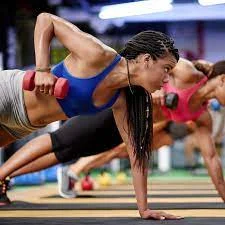
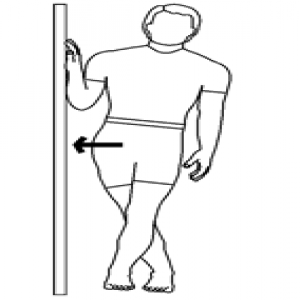

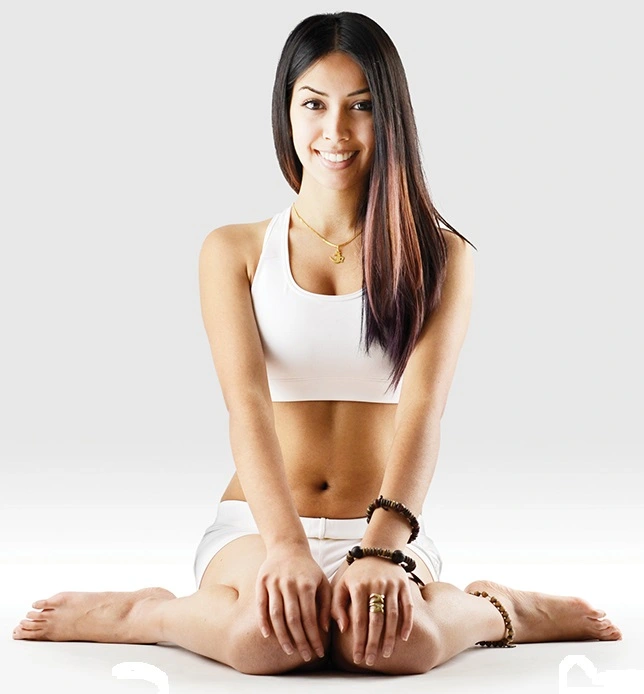


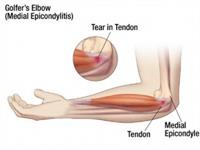
One Comment